 Open Access
Open Access
ARTICLE
Multiobjective Economic/Environmental Dispatch Using Harris Hawks Optimization Algorithm
1 Jansons Institute of Technology, Coimbatore, 641659, Tamilnadu, India
2 Government College of Technology, Coimbatore, 641013, Tamilnadu, India
* Corresponding Author: T. Mahalekshmi. Email:
Intelligent Automation & Soft Computing 2023, 36(1), 445-460. https://doi.org/10.32604/iasc.2023.028718
Received 16 February 2022; Accepted 24 June 2022; Issue published 29 September 2022
Abstract
The eminence of Economic Dispatch (ED) in power systems is significantly high as it involves in scheduling the available power from various power plants with less cost by compensating equality and inequality constrictions. The emission of toxic gases from power plants leads to environmental imbalance and so it is highly mandatory to rectify this issues for obtaining optimal performance in the power systems. In this present study, the Economic and Emission Dispatch (EED) problems are resolved as multi objective Economic Dispatch problems by using Harris Hawk’s Optimization (HHO), which is capable enough to resolve the concerned issue in a wider range. In addition, the clustering approach is employed to maintain the size of the Pareto Optimal (PO) set during each iteration and fuzzy based approach is employed to extricate compromise solution from the Pareto front. To meet the equality constraint effectively, a new demand-based constraint handling mechanism is adopted. This paper also includes Wind energy conversion system (WECS) in EED problem. The conventional thermal generator cost is taken into account while considering the overall cost functions of wind energy like overestimated, underestimated and proportional costs. The quality of the non-dominated solution set is measured using quality metrics such as Set Spacing (SP) and Hyper-Volume (HV) and the solutions are compared with other conventional algorithms to prove its efficiency. The present study is validated with the outcomes of various literature papers.Keywords
Nomenclature
| | probability density function |
| | output power of the wind, |
| | number of wind generators, |
| | operating cost of wind generators, |
| | direct cost function of |
| | reserve cost function of |
| | penalty cost function of |
| | available and scheduled wind power from |
| | reserve cost coefficient of |
| | penalty cost coefficient of |
| | fuel cost of thermal units, |
| | cost coefficient of |
| | actual power generation of the |
| | minimum and maximum generated capacity of |
| | emission coefficient of |
| | emission dispatch function of |
| | total number of hawks. |
The significance of Economics Dispatch (ED) is remarkably high in the power systems since it aims to minimalize fuel expenditure while compensating system constraints by scheduling the output of all available generating units in the power system and hence the recent developments in the power generating sectors have prioritized the process of ED in a wider range [1,2]. The process of resolving the ED issue is used to optimize the usage of fossil fuels in thermal making unit for satisfying the demand while providing the electric power [3]. While trying to solve Emission Dispatch as a single objective function, the corresponding cost gets increased [4]. The single objective ED problem is resolved by treating the emission of Nitrogen oxides (NOx), Sulfur oxides (SOx) as constraints [5]. This emission constraint ED problem is remarkably solved by various researches in [6,7]. Furthermore, the Combined EED (CEED) problem is resolved as a single objective issue through the price penalty factor [8] and weighted sum method [9]. However, these methods are not capable enough to attain the optimal outcome from the non-convex Pareto optimal front since it necessitates multiple runs. To overcome this drawback, the Multi-Objective EED (MOEED) issue is rectified simultaneously as a conflicting objective function.
Over the past few years, multi-objective evolutionary algorithm is used for resolving this problem. Several solution approaches [10–14] are introduced to solve the MOEED problem by producing multiple Pareto optimal solution from a single run.
While integrating thermal generating unit with renewable resources, wind energy is highly feasible since it owns multiple beneficial impacts including low production cost. Initially, the investigators have predicted the future wind speed by employing different approaches like fuzzy logic approach [15], neural network [16], time series model [17]. Hetzer [18] and solved the ED problem in an optimal manner.
The motive of this work is to sort out the MOEED problem with the aid of the newly formulated population-based HHO algorithm, which is capable enough to solve these issues with plenty of advantageous impacts like less complexity, maximal accuracy, simple mechanism, optimal optimization output and randomness. The usage of long-term memory approach aids the convergence characteristics of HHO algorithm by narrowing down the search space. The non-dominated solution set is maintained using the crowding distance method and the fuzzy based methodology is implemented to find the compromising solution. The attained results are compared with various literature papers to prove the efficiency of the work. In addition, a wind energy conversion system is also included with same problem and the results are displayed.
The remaining part of this paper includes modelling of Wind Energy Conversion System (WECS) in Section 2, Formulation of EED problem in Section 3, description of HHO in Section 4, updating process of long term memory in Section 5, description of External Repository Updating Strategy in Section 6, Finding of compromise solution in Section 7, the selection of best Compromise Solution in Section 8, Result analysis in Section 9 and conclusion in Section 10.
2 Modelling and Analysis of WECS
In nature, the wind speed
The transformed wind power is stochastic in nature [20]. Since the wind power is a discrete variable in the zones ([
Probability of wind power being zero:
Probability of rated wind power:
Probability of wind power in continuous zone (
2.1 Operational Cost of Available Wind Generator
The operating cost of wind power can be modelled as,
It consists of three parts. The first part gives the direct cost of wind generators. If the operator has owned the wind farm then this part becomes zero. Else the operator should pay the direct amount to the owner. The direct cost operation is proportional to the scheduled wind power, which is expressed as
The second part of the equation denotes wind generator’s reserve or overestimation cost. When the prevailing wind energy is insufficient to satisfy the demand, this term can be modelled as,
The third term of the equation is the penalty cost or underestimation cost. When the prevailing wind power is excess than the demand this can be modelled as,
The EED includes certain issues like limited Generator capacity, losses in network transition, ramp rate limits and restricted operating zone, which are effectively rectified with the assistance of the introduced optimization approach. By meeting system limitations, the traditional EED issue concurrently lessens the fuel price and ED of thermal units. The constraints and the objective processes are specified in the subsequent section.
3.1 Objective Function1: Minimization of Total Cost
The overall cost of the ED issue is actually the sum of the wind generator’s operational cost and the thermal unit’s fuel cost.
3.2 Objective Function2: Minimization of Emission Dispatch
3.3 Overall Objective Function of EED Problem
The multi-objective, constrained EED issue can be formulated with wind generator is given by,
Minimize
Subject to
Power balance constraints:
where,
Generation capacity constraint
For thermal unit
For wind generator
The author developed a mathematical model using chasing and hunting process of harris hawks and proposed a population based, nature inspired optimization problem [21]. The cooperative hunting style of these hawks includes monitoring, approaching, encircling and attacking the prey. Harris hawks perform the Leapfrog motion whereas they occasionally re-joining and splitting again for the hunting process. The “surprise pounce”, which is otherwise recognized as the “seven kills” approach is the major tactic used by these hawks to catch the prey. According to the developers, exploration and exploitation phases are carried out with perching and besieging process. The pseudo code for HHO is given below:
Inputs: Hawks size N, total number of iterations T, size of memory location K
Output: best position of the rabbit and its fitness value
Set the position of each Hawks
While (the termination condition is fulfilled
Compute the fitness value of each Hawks
Set the position of rabbit
Update memory location with
For each hawk (
Calculate the escaping energy
if
update the position of hawks (
end if
if
Set a random number r from 0 to 1
if (
update hawks location (
else if (
update hawks location (
else if (
update the position of hawks (
else if (
update the position of hawks (
end if
end for
end while
Return
5 Long Term Memory Updating Process in HHO
In hunting strategies of HHO the position of each hawks can be updated based on the single best position
After calculating the probability for each best position of the prey in ML, the selection process is carried out using Roulette Wheel Selection method. During each iteration the size of ML should be maintained constant.
The entire process of ML is depicted in the Fig. 1. Let l be the size of the ML. The best position till
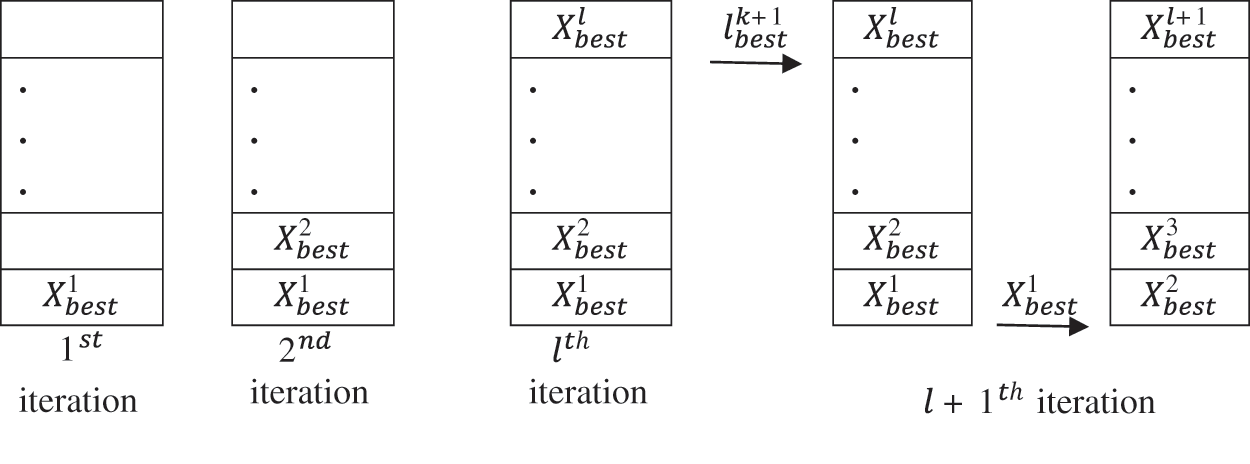
Figure 1: Memory updating process
6 External Repository Updating Strategy
The selection of promising individual for the next iteration is based on the dominance relation. The new feasible solution (
Case 1: At initial stage the
Case 2: If the incoming solution
Case 3: If
Case 4:
Finally, the dominant solutions take a position in the archive controller. The solutions in the controller are non-dominating to each other. This strategy effectively increases the global search mechanism.
7 External Repository Maintaining Strategy
It is required to maintain the size of external repository in every iteration. If the size exceeds the fixed value, the exceeded solutions can be removed by considering the crowding distance. This distance is computed for each solution based on neighboring solutions. The solutions having minimum crowding distance is removed from the repository to maintain the size of the repository.
7.1 Pseudo Code for Maintaining the Size of Repository
if
/* initialize crowding distance as zero*/
for
/*sorting the members of
/* assign
/* calculate
for
end for
/* sort the CD from minimum to maximum and store the index value in I */
/* calculate the excess number of solutions in
/* delete
end if
8 Compromise Solution Selection Using Fuzzy Based Theory
To get at the ideal solution, the best compromise option has to be picked from the solution set. Here the selection process is done based on the fuzzy membership approach, which is significantly illustrated in Fig. 2. The membership value of each individual j for objective function i is given by
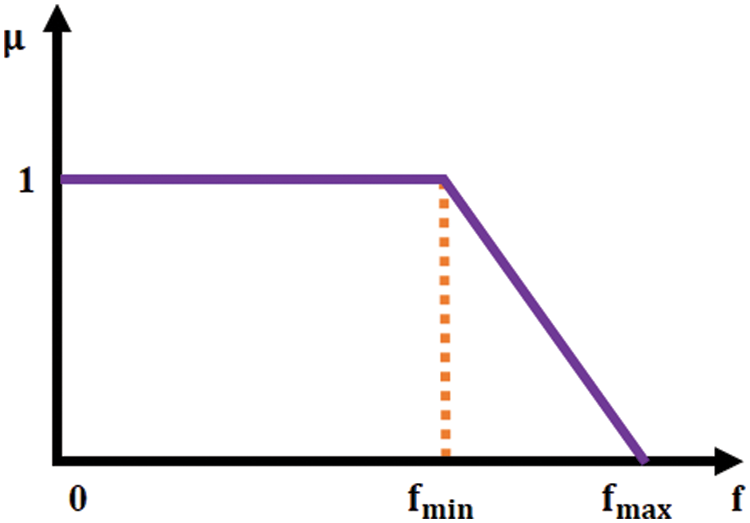
Figure 2: Fuzzy membership function
where
The normalized membership value for j is given by
The solution which has the high membership value i.e.,
The details of transmission losses, coefficients of fuel price and emission are referred from [18]. The system demand is taken as
Case1: To analogize the extreme and compromise solutions with the existing methods, HHO is applied to IEEE 30 bus, 6 generator system. The system is assumed to be lossless.
Case 2: The solution quality of the HHO algorithm is analyzed using performance evaluation indices like SP, HV and CM with the well-known Particle Swam Optimization (PSO) by handling the system with losses.
Case 3: The performance indices of the HHO algorithm is analogized with PSO including wind power.
9.1 Case1: Comparative of Extreme and Compromising Solution
Initially, the HHO algorithm is applied to MOEED problem to obtain the maximum solutions. The MOEED dispatch issue is considered as a single objective issue with emission dispatch or fuel cost to find the optimized value of emission dispatch and minimum fuel cost.
Here, Number of Hawks N = 30, Size of Achieve N_

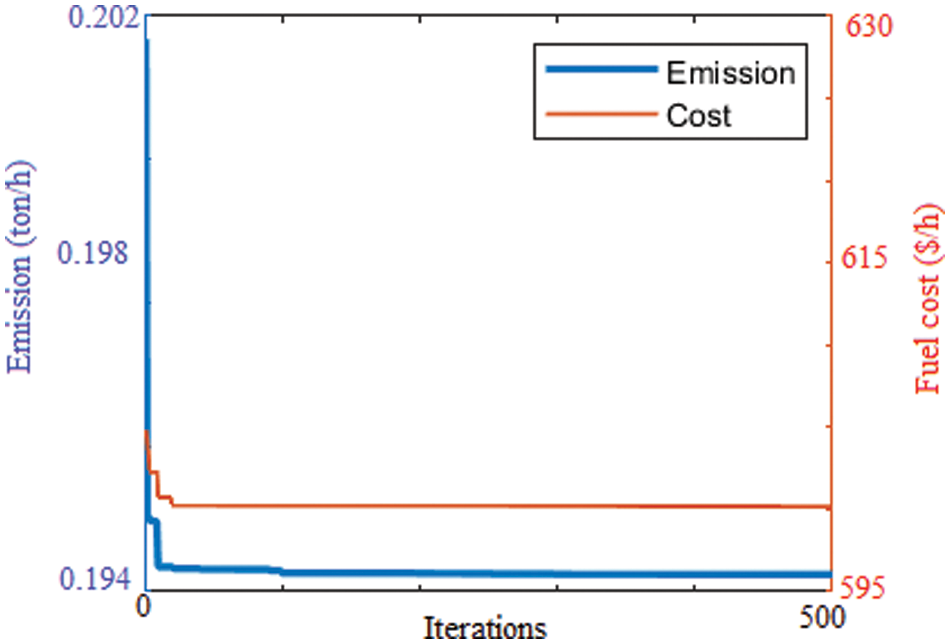
Figure 3: Convergence curve of cost and emission for case1




In case of fuel cost HHO produces the optimum value of 600.11 $/h, which is same as the value obtained from NSGA II, MOACSC, MOGPEA, BB- SMODE and MOPSO. HHO produces better results when compared to FMOEP, NPGA, NSGA, MBFA and MOPSO. The corresponding emission value got improvised than NPGA, FMOEP, NSGA-II and MOACSC. It produces the optimum emission value of 0.1942 ton/h which is same as the results in SPEA, FMOEP, BB-MOPSO, MBFA, NSGA-II, MOPSO, MOGPEA whereas it performs better than NPGA and NSGA.
In addition, the HHO is instigated to regulate the fuel expenditure and ED, which is depicted in Fig. 4. For analogizing the compromise solution with the literature results, Average Satisfactory Degree (ASD) is calculated. Tab. 4 shows that the HHO produces the best ASD (=0.7683) value among the various algorithm reported in literature. Even though it gives high emission dispatch, it proves its efficiency in optimum fuel cost of 609.60 ($/h), which is the ideal compromising solution obtained so far.

Figure 4: NDS-Non dominated solution of HHO for case 1
Case 2: In this case the algorithm is made to run with the population size of


9.2 Evaluation of Solution Quality
Judging multi-objective performance is a tedious task than single objective method. For evaluating the operation of MOEED approach, it is necessary for computing the eminence of attained non-dominated solution in Pareto front. The solution qualities are compared with the well-known algorithm Multi-Objective Mutated Particle Swarm Optimization (MOMPSO). The commonly used quality metrics are Set Spacing (SP) and Hyper Volume (HV) [22]. Tab. 5 gives the comparison of performance measures of SP and HV. The comparison is made by compiling algorithm for 30 runs.
MOMPSO: inertia coefficient
The set spacing aids in measuring the similarity of the attained PO set [23]. The formula for this measure is
where
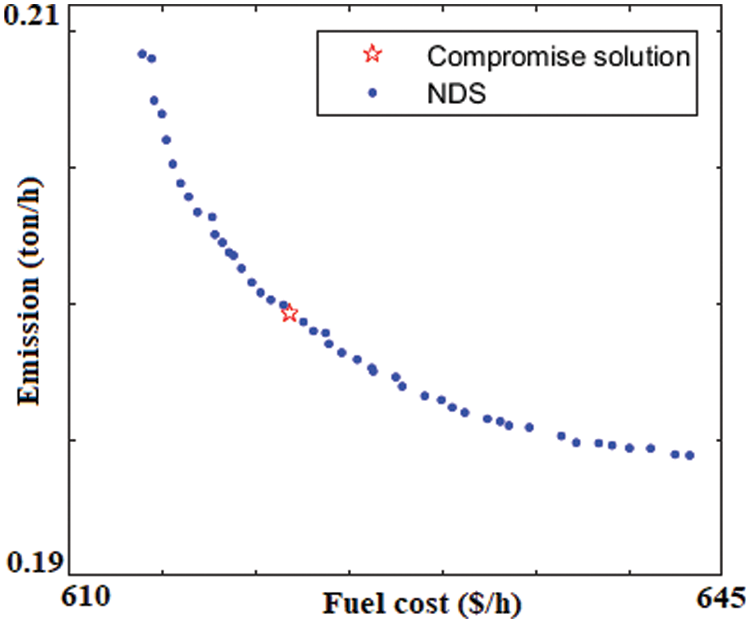
Figure 5: Compromise solution and Pareto front of HHO for case 2
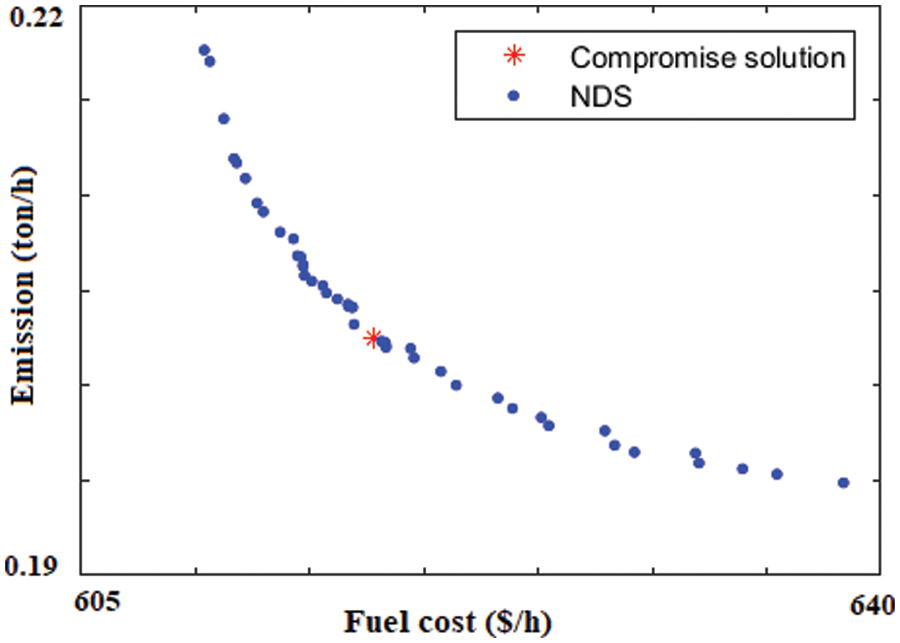
Figure 6: Compromise solution and Pareto front of PSO for case 2
Hyper volume indicator defines the objective function space occupied by the set of non-dominated solution and the reference point
Here the reference point is considered as the worst value of the objective functions. Since it is the minimization optimization problem, the maximum value of the objective function is considered as reference point. The solutions which poses maximum hyper volume treat as superior. From Tab. 5 the HHO takes the superior place by holding the higher value (1.1073) than PSO
Case 3: In this case the compromising solution and the performance metrics are compared and analyzed for the system with losses and wind generator. Here the 6 thermal generators are accommodated with one wind generator, cut-out wind speed vo is
The scheduling of demand among the thermal generator and the wind generator is shown in Tab. 8. According to this the HHO algorithm gives the less fuel cost when compared to PSO. The higher ASD value (0.75205) of HHO prove its efficiency in solving the MOEED problem. The statistical results for case3 are depicted in Tab. 9.


The present study has employed a novel long term memory based HHO technique for significantly optimizing the MOEED problem. With the assistance of Clustering technique, the size of PO set is maintained along with the well distributed solutions whereas the compromising solution is extracted from the non-dominated solutions through the implementation of Fuzzy based method. The entire work is validated through IEEE 30 bus 6 generator system and the attained outcomes prove that the HHO produces the optimum outputs than the other optimization approaches. The coding is developed in MATLAB and run-in Intel core i5 processor 2.5 GHz/8GB-RAM system. Moreover, the quality of the non-dominated solutions is examined and analogized with the PSO approach. Therefore, it is validated that the introduced methodology produces optimum solution in solving the MOEED problems.
Funding Statement: The authors have received no specific funding for this study.
Conflicts of Interest: The authors declare that they have no conflicts of interest regarding the present study.
References
1. G. Abbas, J. Gu, U. Farooq, A. Raza, M. U. Asad et al., “Solution of an economic dispatch problem through particle swarm optimization: A detailed survey–Part II,” IEEE Access, vol. 5, pp. 24426–24445, 2017. [Google Scholar]
2. B. Dey, B. Bhattacharyya and F. G. P. Márquez, “A hybrid optimization-based approach to solve environment constrained economic dispatch problem on microgrid system,” Journal of Cleaner Production, vol. 307, pp. 127196, 2021. [Google Scholar]
3. D. W. Ross and S. Kim, “Dynamic economic dispatch of generation,” IEEE Transactions on Power Apparatus and Systems, vol. 99, no. 6, pp. 2060–2068, 1980. [Google Scholar]
4. M. R. Gent and J. W. Lamont, “Minimum-emission dispatch,” IEEE Transactions on Power Apparatus and Systems, vol. 6, pp. 2650–2660, 1971. [Google Scholar]
5. J. K. Delson, “Controlled emission dispatch,” IEEE Transactions on Power Apparatus and Systems, vol. 5, pp. 1359–1366, 1974. [Google Scholar]
6. A. A. Abou El Elaa, M. A. Abidob and S. R. Speaa, “Differential evolution algorithm for emission constrained economic power dispatch problem,” Electric Power Systems Research, vol. 80, pp. 1286–1292, 2010. [Google Scholar]
7. G. P. Granelli, M. Montagna and G. L. Pasini, “Emission constrained dynamic dispatch,” Electric Power Systems Research, vol. 24, pp. 55–64, 1992. [Google Scholar]
8. U. Guvença, Y. Sonmezb, S. Dumanc and N. Yorukerend, “Combined economic and emission dispatch solution using gravitational search algorithm,” Scientia Iranica D, vol. 19, no. 6, pp. 1754–1762, 2012. [Google Scholar]
9. C. R. E. S. Rex, M. Marsaline Beno and J. Annrose, “A solution for combined economic and emission dispatch problem using hybrid optimization techniques,” Journal of Electrical Engineering & Technology, 2019. DOI 10.1007/s42835-019-00192-z [Google Scholar]
10. M. A. Abido, “A niched pareto genetic algorithm for multiobjective environmental/economic dispatch,” Electrical Power and Energy Systems, vol. 25, pp. 97–105, 2003. [Google Scholar]
11. M. A. Abido, “A novel multiobjective evolutionary algorithm for environmental/economic power dispatch,” Electric Power Systems Research, vol. 65, pp. 71–81, 2003. [Google Scholar]
12. M. Basu, “Dynamic economic emission dispatch using non dominated sorting genetic algorithm-II,” Electrical Power and Energy Systems, vol. 30, pp. 140–149, 2008. [Google Scholar]
13. M. A. Abido, “Multiobjective evolutionary algorithms for electric power dispatch problem,” IEEE Transactions on Evolutionary Computation, vol. 10, no. 3, pp. 47–82, 2006. [Google Scholar]
14. Z. Hu, Z. Li, C. Dai, X. Xu, Z. Xiong et al., “Multiobjective grey prediction evolution algorithm for environmental/economic dispatch problem,” IEEE Access, vol. 8, pp. 84162–84176, 2020. [Google Scholar]
15. I. G. Damousis, M. C. Alexiadis, J. B. Theocharis and P. S. Dokopoulos, “A fuzzy model forwind speed prediction and power generation in wind parks using spatial correlation,” IEEE Transactions on Energy Conversion, vol. 19, no. 2, pp. 352–361, 2004. [Google Scholar]
16. S. Li, D. C. Wunsch, E. A. O’Hair and M. G. Giesselmann, “Using neural networks to estimate wind turbine power generation,” IEEE Transactions on Energy Conversion, vol. 16, no. 3, pp. 276–282, 2001. [Google Scholar]
17. B. G. Brown, R. W. Katz and A. H. Murphy, “Time series model to simulate and forecast wind speed and wind power,” Journal of Climate and Applied Metrology, vol. 23, no. 8, pp. 1184–1195, 1984. [Google Scholar]
18. J. Hetzer, D. C. Yu and K. Bhattarai, “An economic dispatch model incorporating wind power,” IEEE Transactions on Energy Conversion, vol. 23, no. 2, pp. 603–611, 2008. [Google Scholar]
19. S. Roy, “Market constrained optimal planning for wind energy conversion systems over multiple installation sites,” IEEE Transactions on Energy Conversion, vol. 17, no. 1, pp. 124–129, 2002. [Google Scholar]
20. Y. Liu and N. K. C. Nair, “A Two-stage stochastic dynamic economic dispatch model considering wind uncertainty,” IEEE Transactions on Sustainable Energy, vol. 7, no. 2, pp. 819–829, 2015. [Google Scholar]
21. S. Mirjalili, H. Faris, I. Aljarah, M. Mafarja and H. Chen, “Harris hawks optimization: Algorithm and applications,” Future Generation Computer Systems, vol. 97, pp. 849–872, 2019. [Google Scholar]
22. J. R. Schott, “Fault tolerant design using single and multicriteria genetic algorithm optimization,” B.S United States Air Force, pp. 1–201, 1995. [Google Scholar]
23. A. Auger, J. Bader, D. Brockhoff Eckart and E. Zitzler, “Theory of the hypervolume indicator: Ooptimal μ-distributions and the choice of the reference point,” in Proc. of the Tenth ACM SIGEVO Workshop on Foundations of Genetic Algorithms, New York, NY, United States, pp. 87–102, 2009. [Google Scholar]
24. J. V. Seguro and T. W. Lambert, “Modern estimation of the parameters of the weibull wind speed distribution for wind energy analysis,” Journal of Wind Engineering and Industrial Aerodynamics, vol. 85, pp. 75–84, 2000. [Google Scholar]
Cite This Article
 Copyright © 2023 The Author(s). Published by Tech Science Press.
Copyright © 2023 The Author(s). Published by Tech Science Press.This work is licensed under a Creative Commons Attribution 4.0 International License , which permits unrestricted use, distribution, and reproduction in any medium, provided the original work is properly cited.


 Submit a Paper
Submit a Paper Propose a Special lssue
Propose a Special lssue View Full Text
View Full Text Download PDF
Download PDF Downloads
Downloads
 Citation Tools
Citation Tools